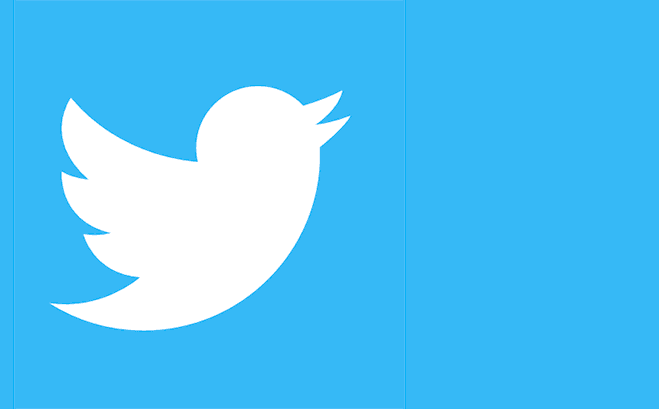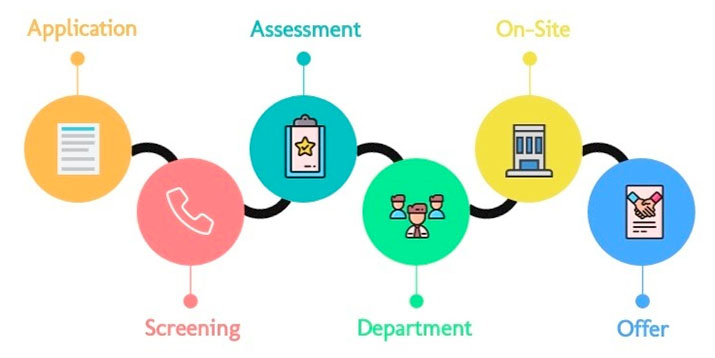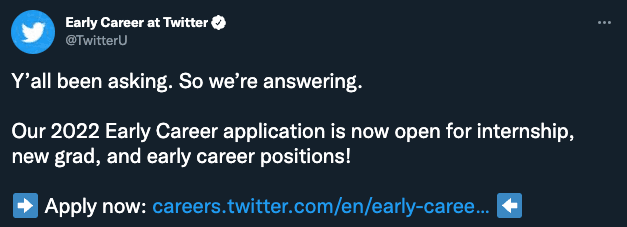Twitter Interview Process: Everything You Need To Know
Twitter is a fast-growing social media company and an incredibly popular company with people seeking jobs in tech. We'll walk you through the entire job application process.

What Does The Application Process At Twitter Look Like?
Twitter gets a lot of applications. In response, they've developed a unique hiring process that's designed to differentiate between very good applicants and excellent ones.
The process can take anywhere from weeks to months depending on things like how urgently they need the position filled and how quickly you complete each stage. With that being said, on average the process takes between two and six weeks from start to finish, depending on the role you're applying for.
While marketing and support take less amount of time, the interview process of product management roles can last up to six weeks.

Twitter’s interview process itself contains between 4 to 6 rounds of interviews which will be discussed in more detail below.
Week 0: Online Application
The first step in the hiring process is filling out an online form on Twitter Careers with some basic information about yourself and uploading your resume along with a cover letter. Nothing mind-blowing here!
If you want to leave a strong impression, it's important to make your cover letter and resume relevant to the role you’re applying for. Go through the job listing and include keywords they may be looking for. Make sure that you know Twitter and their history to prepare yourself for questions related to cultural fit.
So many applicants squander their cover letters' self-promotional potential by confusing long winded dullness with professionalism. Great cover letters are conversational, engaging, and straight to the point. They help recruiters see you as a fleshed-out person rather than a collection of facts and anecdotes. If you’re applying for an internship, make sure to follow @TwitterU to understand what the company is looking for in early-career applicants:
Week 1: Screening Interviews
If a recruiter likes your application, you should receive an email with information about scheduling a phone or video interview (usually conducted over Google Meet). Depending on the position you applied for, this email might also include some review materials to help you prepare for the more technical questions you'll be asked.
The phone interview begins like most stock-standard job interviews. The hiring manager will tell you about the company and position, and you'll tell them why you're a perfect fit. Sometimes, these phone screens include an assessment element (discussed below), other times the two are scheduled separately.
Duration: 30 minutes
Week 1: Assessment Round
As mentioned above, there's also an assessment round within these initial interviews. The aim of this round is to get a sense of your technical skills and creative problem-solving abilities. How and when applicants are screened will depend on the position itself. In some cases, screening assessments will be conducted live. In others, assessments will be take-home.
For positions that don't require programming (e.g., marketing, administration, or accounting roles), applicants are screened based on their prior experience and through targeted questions about how they would act in hypothetical situations.
For positions that do require programming, applicants are screened through tests conducted over HackerRank CodePair. The process is pretty straightforward: you'll get tasks to complete and your interviewer will watch as you try to complete them as quickly and elegantly as possible.
Duration: 45 minutes
Week 3: Departmental Round
Based on your performance in the screening and assessment rounds, the hiring manager will reach out to schedule additional interviews - this time with the department you'll (hopefully) be working with shortly.
As you might expect, these interviews tend to focus on the day-to-day requirements of the position you're applying for. You'll be asked questions about the work itself and how you might contribute to the team if hired.
Duration: 45 minutes
Week 5: On-Site Round
If you do well in the screening round, you'll be asked to come in for a series of on-site interviews at a Twitter office, or remotely for remote positions. Before heading in, expect two phone calls from HR:
- Team Preferences: In the first call you'll be asked what teams you'd like to work with within your position's department. Think carefully about this, because the teams you choose will be interviewing you on-site!
- Interview Structure: In the second call, HR will give you a rundown of what you can expect from the on-site interviews. You'll also get a chance to ask questions!
The number of interviews you'll need to attend will vary from position to position, but typically, applicants are scheduled for 3 to 5 interviews. Each will have its own focus, assessments, and team of two interviewers, so you’ll need to be able to switch your thinking quite effectively.
Would you like a 4 day work week?
Engineering
Engineering interviews are conducted by teams of two engineers. You'll be expected to demonstrate your technical know-how and under-the-hood product knowledge through conversation and situational problem-solving.
Customer Experience
Customer experience interviews will be focused on figuring out just how well you understand Twitter's users (demographics, motivations, experiences, etc.). As a Twitter user yourself nudge nudge, feel free to include personal experiences and anecdotes in your responses.
Product Sense
Twitter is incredibly product-focused. In product sense interviews your understanding of Twitter users will be tested from a number of different angles. As a product manager (AKA “Tweep”), You should be able to accurately describe why different groups use Twitter, explain how design and feature choices impact users, and offer input into what Twitter's path forward looks like.
Topgrading
Topgrading refers to the practice of grading applicants based on their current ability to meet the position's requirements. Here, they’ll ask you questions about your past employment, including successes, mistakes, management style, reasons for quitting your job, and so on. In the next section, we’ll provide a framework to help you effectively answer these questions.
'A-grade' applicants could start working tomorrow and be perfectly fine. 'C-grade' applicants would need a bit of coaching. Expect to give a detailed account of your relevant experiences and skills.
Leadership
Leadership interviews typically happen after 5 rounds of interviews and are reserved for high-level management positions, such as department heads and executives. Questions in these interviews will focus on your experience and abilities when it comes to leading teams and motivating others.
Total Duration: ~2.5 hours
Week 5: Final Round
Some (mainly engineering) applicants have reported a final round of interviews after the on-site visit or remote interview rounds. This is usually an informal phone or video meeting with two members of company management where they assess your ability to fit in with the culture at Twitter. These calls are essentially just friendly conversations aimed at helping you envision what working at Twitter is like. After all, the company doesn't want to hire someone who'll be unhappy working for them!
Duration: ~1 hour
Week 6: Official Offer
If you make it to the end of the interview process, congratulations! You're officially in the running. All you need to do now is wait.
If you get the job, Twitter will contact you with an official offer and go over the details of the compensation and benefits package they're offering.
How Can You Prepare For Your Interviews?
Interviews (and interview-based assessments) are a huge part of Twitter's hiring process. If you want the job, you need to interview well.
According to a study conducted by Twin Employment, 40% of hiring managers cite “lack of confidence during an interview” as their most common reason for not taking applicants further in the hiring process. Is that harsh? Maybe, but it's an unfortunate truth.
The best way to boost your confidence going into an interview is to prepare. The best way to prepare is to have a strategy for answering questions. We’ll provide a sample question to answer using the STAR framework.
The STAR Interview Framework
The STAR framework is a helpful system for structuring your responses to interview questions in a way that makes them more meaningful, relevant, and complete. STAR is an acronym, so it's easy to remember, too! It stands for:
- Situation: Is there any background information required to understand the response?
- Task: What responsibilities were you tasked with in this situation?
- Action: What actions did you engage in to satisfy these responsibilities?
- Result: What was the result of these actions?

Following the STAR framework is great for several reasons. For starters, it makes sure your answers are giving the interviewer all the information they need.
How To Use The STAR Framework In Your Twitter Interviews
To illustrate the STAR framework in action, let's try it out on a common behavioural interview question:
Tell me about a time when you worked under close supervision or extremely loose supervision. How did you handle it?
- Situation: "One time I had to work under extremely loose supervision was when I was chosen to lead a team looking into the viability of a possible expansion opportunity. I had very little oversight over the course of the project."
- Task: "I was responsible for coordinating the team's efforts, ensuring research was high-quality, meeting project timelines, and reporting key insights to other departments."
- Action: "To make sure progress was efficient and effective I worked with the team to delegate responsibilities based on abilities and preferences. I also worked hard to make sure data was accurate and well supported."
- Result: "My team ended up completing the project ahead of schedule and our research was relied on heavily in discussions about the possible expansion. I am confident that I can perform under similar conditions at Twitter. "
As you can see, the STAR framework lets you cover all your bases with every answer you give. In this example, the question didn't explicitly ask about results, but you can be sure that any interviewer will appreciate hearing about them!
Interviewing for a job is scary enough without the added uncertainty of not understanding the interview process. The good news is that Twitter is very transparent about what you can expect. With a little guesswork you can predict what your experience will look like with a decent amount of accuracy - including what kinds of things you'll be asked to do and talk about. With a little preparation and some good responses, you might just land yourself a job!
